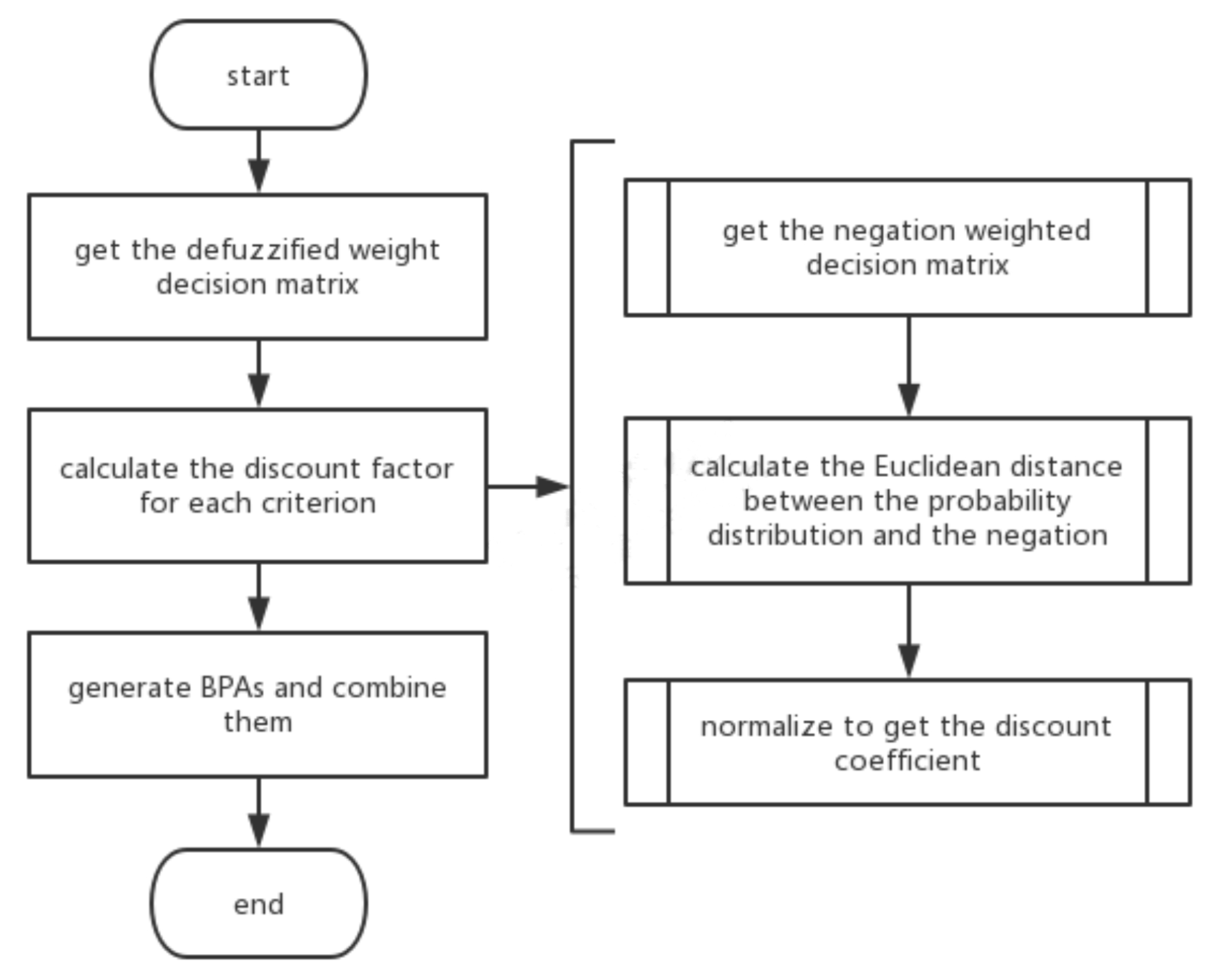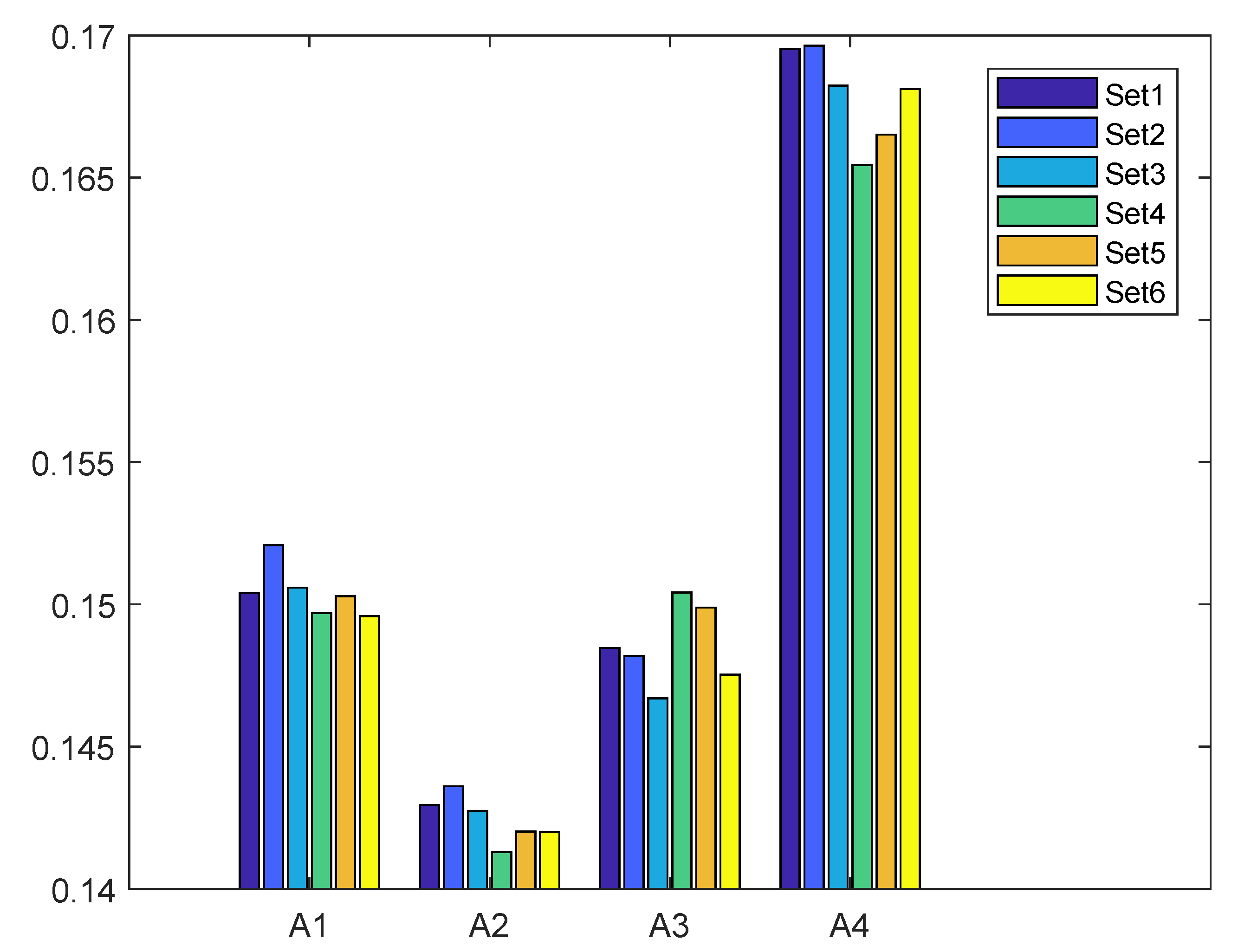1. Introduction
Multi-criteria decision making (MCDM) refers to the decision making in the limited or infinite set of conflicting schemes. According to whether the alternatives are limited or infinite, MCDM can be divided into multi-attribute decision making (limited) and multi-objective decision making (infinite). In essence, multi-attribute decision-making is mainly used to study the evaluation and optimization of known schemes, and multi-objective decision-making is mainly used to study the planning and design of unknown schemes. This paper mainly discusses the multi-attribute decision-making problem with multiple conflicting attributes. According to the performance of each scheme under different criteria, it carries out a comprehensive evaluation, and then selects the best scheme from the limited schemes. Most of the project decision-making problems in our life can be modeled as multi-criteria decision making problems [
1,
2,
3,
4,
5]. Because of its universality and importance, the exploration of such problems has shown progress. Many math tools are presented to deal with multi-criteria decision-making, such as fuzzy sets [
6,
7,
8,
9,
10,
11], which offer a framework to address uncertainty and vagueness; soft sets [
12,
13,
14]; evidence theory [
15,
16,
17,
18,
19], which enables any union of classes to be addressed and expresses both uncertainty and imprecision; Z numbers [
20], which can not only express uncertainty, imprecision and incompleteness of information but can also represent the reliability of information; D numbers [
21,
22], which are more capable of expressing and handling both uncertainty and imprecision; network modeling [
23,
24,
25]; etc. [
26].
In the process of solving multi-criteria decision making problems, the determination of criteria weight is very important. It is used to reflect the relative importance of a certain criterion. If a certain criterion is relatively important, it is given a relatively large weight; otherwise, it is given a relatively small weight. There are three methods to determine the weight: subjective method, objective method, and comprehensive method. At present, the general solution is the comprehensive method. First, the alternatives are subjectively evaluated by experts based on various criteria. Then, the linguistic evaluation is converted to the corresponding quantitative evaluation; a comprehensive measure of subjective evaluation and objective reflection is calculated through certain rules; and finally the alternatives are evaluated, ranked and optimized [
27,
28]. On this basis, Fei et al. developed a MCDM method where the evaluation information is expressed and handled by Dempster–Shafer theory [
29]. In the evaluation of a scheme, the evaluation under each criterion affects the final result to some extent [
30,
31,
32]. Due to the relative importance difference between different criteria, the final evaluation results are obtained by evaluating the importance degree of each criterion and weighting the evaluation based on each criterion, respectively. The relatively important criterion has a larger weight, and the corresponding evaluation of the criterion has a greater impact on the final results. On the contrary, the relatively unimportant criterion has a smaller weight, and the corresponding evaluation of the criterion has a smaller impact on the final result. Thus, we need to assign an appropriate weight to each influencing factor carefully to reduce the impact of subjective factors on the result. To solve this problem, we carefully studied some methods to determine the combination weight, such as the method for obtaining ordered weighted average OWA weights proposed by Xu, which can relieve the influence of unfair arguments on the decision results [
33]; the method to obtain a weights vector [
34] proposed by Lamata et al.; the PPMIS (Project and Portfolio Management Information Systems) selection/evaluation approach that combines TOPSIS (Technique for Order Preference by Similarity to Ideal Solution) with intuitionistic fuzzy group decision making presented by Gerogiannis et al. [
35]; and two reliability-based combination rules are used to synthesize multi-source information [
36].
Furthermore, to improve the level of decision-making in uncertain environment, researchers have previously carried out long-term and in-depth studiesy. Srivastava et al. defined a new entropy function for determination of uncertainty associated with the negation of a probability distribution and the events associated with it [
37]. Srivastava et al. also developed uncertainty measures that measure the uncertainty associated with the negation of a probability distribution [
38]. Luo and Deng presented a new definition of negation of BBA [
39], which is used to measure fuzziness for D-S theory. Xie and Xiao proposed negation method of BPA based on the maximum uncertainty [
40]. The negation of probability distribution provides a new view to represent the uncertainty information, which leads to the application of negation of probability distribution in related fields and in-depth exploration [
41]. In addition, the negation model has the maximum entropy allocation, which attracts studies on uncertainty measures that can be applied in the negation process.
Recently, Xiao proposed a method of evidence fuzzy multi-criteria decision-making based on belief entropy, named as EFMCDM [
42]. The combination of D-S evidence theory and belief entropy should be used to solve the problem of multi-criteria decision making. First, the experts evaluate the linguistic rating of all alternatives and the importance of each criterion based on each criterion. Then, the fuzzy number is used to transform the language level evaluation into quantitative evaluation of numbers, and then the weighted decision matrix is obtained through a series of calculations. Then, the D-S evidence theory is used to model the whole scheme into a complete identification framework, and the BPA of each criterion is generated by using the belief entropy. After fusing multiple pieces of evidence, the best scheme is selected according to the belief value of the alternatives. In the process of decision-making, EFMCDM considers the influence of subjective and objective weight, and builds a quantitative model of uncertainty, which successfully reduces the uncertainty brought by human subjective cognition and improves the decision-making level.
However, EFMCDM does not consider the fuzziness of evaluation criteria. To further improve the decision-making level, this paper proposes a weights-determining method in MCDM based on negation of probability distribution [
43] under uncertain environment. In the process of constructing the weighted decision matrix, it can be found that the column elements in the final weighted decision matrix satisfy the probability distribution. The probability distribution of each criterion has its corresponding negation, thus the distance between the probability distributions and its negation can be used to measure the fuzzy degree of the corresponding criterion. Specifically, this paper mainly deals with the weight determination method of the multi-attribute decision-making problem, aiming at the optimization problem of limited schemes, using the negation of (discrete) probability distribution to propose feasible solutions. As defined in the original paper [
43], the negation of a (discrete) probability distribution is based on the sample size and closely related to the sample probability measure. Because the number of schemes and criteria is limited, and the weights of different schemes with the same criteria meet the definition of discrete distribution after normalization, the negation of probability distribution can be applied to the weight determination of multi-attribute decision making.
Here is an example to understand the above ideas. Two sets of propositions are considered: proposition “he may be a good man” and its negative proposition “he may not be a good man”, and proposition “he is absolutely a good man” and its negative proposition “he is absolutely not a good man”. Compared with the second group, the two propositions in the first group can obviously feel their distance is closer, and this group of propositions is also more fuzzy. Therefore, the fuzzy degree of a proposition can be measured by the distance between a proposition and its negation. The higher is the fuzzy degree of a criterion, the greater is the uncertainty of the criterion, and the smaller is the corresponding discount coefficient; conversely, the lower is the fuzzy degree of a criterion, the smaller is the uncertainty of the criterion, and the larger is the corresponding discount coefficient. Based on the negation of probability distribution, the fuzzy degree of the criterion is taken as the reference standard to calculate the discount coefficient of the criterion, and then the BPA of the criterion is generated and combined. In this way, the errors caused by the experts’ subjective evaluation of each standard are corrected and the decision-making level is improved.
The main aim of this study is to provide a new way to solve the multi criteria decision-making problem by combining the negation of probability distribution and evidence fusion from the point of quantitative description of the fuzzy degree of criteria.
3. Proposed Method
In this section, we introduce a multi-criteria decision-making method based on negation of probability distribution. The specific flow chart is shown in
Figure 1. By combining the D-S evidence theory with the negation of probability distribution, the fuzzy degree of the criterion is taken as the reference standard to calculate the discount coefficient of the criterion, which corrects the errors brought by the experts’ subjective evaluation of each criterion and improves the decision making level.
Problem statement: Let a set of m possible exclusive alternatives be the frame of discernment, be the set of n decision criteria, and be the set of t decision makers. A set of fuzzy ratings for with respect to the criteria given by the decision maker is denoted as , where , and a set of fuzzy importance weights for given by the decision maker is denoted as , where . Consider this fuzzy MCDM problem: The best candidate should be selected from .
Step 1: According to Xiao’s idea [
42], obtain the normalized defuzzified weight decision matrix
.
Step 1-1: Multiply fuzzy coefficient
and fuzzy importance weight
to get weighted fuzzy coefficient
, where the superscript
w is used to represent the weight of importance of different criteria. Due to different decision makers having different judgments on the importance degree of different criteria, by scalar multiplication, the weight factors (
) of the same criteria of the same decision-maker and the importance factors (
) of the criteria are multiplied correspondingly, and the weighted weight factors (
) of a decision-maker for a scheme under a certain criterion are obtained. Then, the weighted fuzzy coefficient matrix
is obtained:
Step 1-2: The aggregated fuzzy value
of weighted fuzzy value and the aggregated decision matrix
are obtained by considering the evaluation of
t decision-makers. Then, the aggregated fuzzy values are normalized and defuzzified, respectively. Then, the defuzzified weight decision matrix
is obtained. After another normalization, obtain
. Then, the normalized defuzzified weight decision matrix is obtained:
Step 2: Calculate the discount factor for each criterion.
Step 2-1: Since the column elements of the above matrix are obtained by normalization,
, each column conforms to the characteristics of probability distribution. Through the negation formula,
the negation weighted decision matrix
can be obtained.
Step 2-2: For each criterion
, the Euclidean distance
between the probability distribution and the negation is calculated.
Step 2-3: Normalize to get the discount coefficient
of each criterion.
Step 3: Generate BPAs and combine them.
Step 3-1: According to the following formula, BPA corresponding to each proposition
is generated based on each criterion
.
Step 3-2: Through (n−1) times orthogonal sum operation, BPAs of different criteria are combined with each other.
Step 3-3: According to the value of
, the scheme
with the largest
is the best scheme, and the best scheme may not be unique.








